 ?Mathematical formulae have been encoded as MathML and are displayed in this HTML version using MathJax in order to improve their display. Uncheck the box to turn MathJax off. This feature requires Javascript. Click on a formula to zoom.
?Mathematical formulae have been encoded as MathML and are displayed in this HTML version using MathJax in order to improve their display. Uncheck the box to turn MathJax off. This feature requires Javascript. Click on a formula to zoom.Abstract
Objectives
The present study was designed to formulate a remediation program for Arabic speaking children suffering from dyslexia based on improving phonological awareness using materials appropriate for Arabic culture.
Methods
The study was carried out at the unit of Phoniatrics, Faculty of Medicine, Alexandria main university hospital. The subjects were divided into two groups. Group I: 30 dyslexic children of both sexes in the age range of 6½–10½ years on which the proposed remediation programme was applied. Group II: 30 dyslexic children age and sex matched were included as a control group; they received no remediation programs during the time of conduction of the study. The formulated Arabic remediation program was based on improving the phonological awareness for dyslexic children, after the Phonological Awareness Training for Reading Program. Modifications and additions were made to suit the nature of the Arabic language, and face the differences between Arabic and English orthography. The program was divided into sound blending, sound segmenting, reading and spelling activities. The training program was applied twice weekly, with session duration lasting from 25 to 30 min. Each session had about 2 or 3 children. The studied groups were subjected to protocol for evaluation of dyslexia before and after therapy to document to evaluate the improvement and the stability in the condition of these children.
Results
The presented training program significantly improved reading, writing and phonological awareness of dyslexic cases.
Conclusion
The present study highlighted the importance of phonological awareness skills as a prerequisite for emergence of literacy skills. The program was modified to suit Arabic speaking Egyptian children. The study found that the age of the child is the most important predictor factor, the younger the age of intervention the better the outcome of therapy program.
Abbreviation:
1 Introduction
Developmental dyslexia is defined as an unexpected difficulty in reading in children and adults who otherwise possess the intelligence and motivation considered necessary for accurate and fluent reading and who also have had reasonable reading instruction. It has a prevalence estimated between 5 and 10%.Citation1 Many theories have been postulated aiming to highlight the etiological basis of dyslexia, the most developed and supported theory for dyslexia is the phonological deficit theory. An emerging consensus is that developmental dyslexia is characterized by difficulties in language processing. These difficulties are primarily at the level of phonological processing of speech sounds, specifically phonological awareness, which is the ability to recognize and manipulate the sound structure of words.Citation2
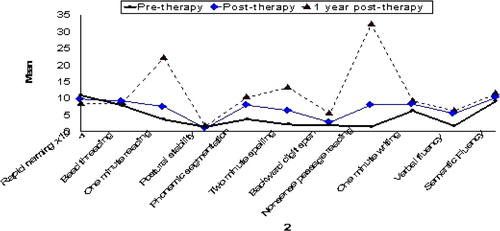
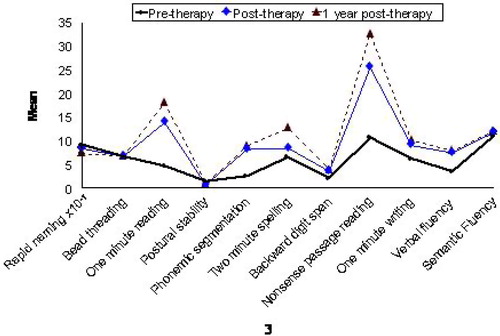
Children with dyslexia do not easily acquire the basic phonologic skills that serve as a prerequisite to reading; consequently, management of dyslexia demands explicit teaching of concepts such as phoneme awareness. Operationally, this is accomplished with systematic and highly structured training exercises.Citation3
There is a need to develop an Arabic remediation program as the Arabic language differs from western languages in many aspects, the most important of which are: (a) unlike western languages Arabic is written from right to left; (b) Arabic is always written in script form (with letters joined), whereas the letters may be separated (in block) in western languages; and (c) Arabic alphabets do not contain directionally confusing letters such as b–d, p–q, n–u, and w–m.Citation4
Most Arabic letters have more than one written form, depending on the letter's place in a word: beginning, middle or end. However, the essential shape of the letter is maintained in all cases.Citation5 In addition, the letters are divided into categories according to basic letter shapes, and the difference between them is the number of dots on, in or under the letter. Dots appear with 15 letters, of which 10 have one dot, 3 have two dots and 2 have three dots. In addition to the dots, there are diacritical marks that contribute phonology to the Arabic alphabet.Citation6 Arabic words are a combination of consonants and vowels.
The Arabic script is fairly unusual in its transparency, transparency here refers to the association between written symbols and language sounds. A transparent script has a simple one-to-one relationship, whereas less transparent scripts, such as English, have a much more complex relationship between letters and sounds. The use of diacritical markers in beginning readers’ texts makes the script highly transparent (texts that include diacritics that represent short vowel are referred to as vowelised texts). However, these short vowel markers are absent in the majority of more advanced written works (i.e., nonvowelised texts), which produces a highly opaque script with a large number of homographs that can only be pronounced correctly through an appreciation of the context within which they are written. Once the readers have progressed beyond first- or second-grade texts, therefore, they would be expected to be able to process non-vowelised (highly opaque) text.Citation7
The impact of phonological processes on literacy acquisition in Arabic learning has been studied in Bahraini children and the results indicated the potential importance of phonological processes as predictors of early literacy in this cohort of Arabic-speaking children.Citation8 Remediation of dyslexia when emphasizing the role of phonological awareness training programs will have a beneficial impact on the reading skills of dyslexic children. There has been a defect in the remediation programs of children with the Arabic language as their native language.
2 Aim of the study
The present study aimed to design, formulate and evaluate a remediation program of intervention for dyslexic children based on improving phonological awareness using materials appropriate for Arabic speaking children.
3 Subjects
The subjects in this study were divided into two groups: Group I: A group of 30 dyslexic children of both sexes in the age range of 6½–10½ years enrolled in the grades of elementary schools, recruited from cases attending the unit of Phoniatrics, Faculty of Medicine, Alexandria University. Only after obtaining a full informed consent from both (or the attending) parent(s), as well as the approval of the ethics committee of the Faculty of Medicine, Alexandria University, the proposed remediation program was applied on this group. Exclusion criteria included learning difficulties due to mental subnormality, associated attention deficit hyperactivity disorder, hearing impairments and central auditory processing disorders.
Group II: Another group of 30 dyslexic children age and sex matched were included as a control group; they received no remediation programs during the time of conduction of the study, this was either due to refusal of parents to attend therapy sessions during the school year, or due to long distance and inability to attend sessions during winter.
4 Methods
4.1 The steps of the study proceeded as follows
4.1.1 Formulation of the remediation program in Arabic language
This program was based on improving the phonological awareness for dyslexic children, after the Phonological Awareness Training for Reading Program.Citation9 Some modifications were made, and some steps were added to the program to suit the nature of the Arabic language, and to face the differences between Arabic and English orthography. The program included rhyming activities to help children focus their attention on the sounds in words, followed by sound blending activities where children started the formal training program with activities that teach them to blend individual sounds to make words. These were followed by Sound segmenting: activities. In the final phase of instruction, children were taught how to use their phonological awareness skills in reading and spelling.
Each patient was subjected to the thorough evaluation for identification of children with attention deficit hyperactivity disorder, neurotic traits, mood disorders, aggression, impulsivity and depression for exclusion. Psychometric evaluation were included: Stanford Binet test: to assess intelligence quotient (IQ) and mental age,Citation10 and Wechsler Intelligence scale for children was also performed.Citation11 Language assessment was formally conducted using Arabic language test.Citation12 Evaluation of dyslexia using the Arabic dyslexia assessment test.Citation13 for determination of weaknesses and strengths in the child's performance. Ophthalmologic evaluation: to exclude visual impairments. Audiological assessment was performed to exclude hearing impairment and central auditory processing problems.
4.1.2 Application of the training program
The training program was applied to group I. subjects they attended the training sessions twice weekly, with session duration lasting from 25 to 30 min. Each session had about 2 or 3 children who were age and performance matched.
4.1.3 To reevaluate dyslexia in both groups post therapy
The initial protocol for evaluation of dyslexia was applied after therapy for both groups, and also one year after therapy to group I to evaluate the improvement and the stability in the condition of these children.
5 Statistical analysis
Statistical analysis was done using Statistical Package for Social Sciences (SPSS/version 15) software and the mean (
), standard deviation (SD), student t-test and (ANOVA) or (F-test) were computed, also Duncan's new multiple range test (MRT) was used to compare sets of means.
6 Results
shows the age distribution in both group I and group II, they were distributed into 4 age groups in each group. There was no significant difference between both groups regarding age group distribution () (p = 0.97). Males accounted for almost 70% in both groups. There was no significant difference between them (p = 0.48).
Table 1 Distribution of age group in the two studied groups.
6.1 Results of the Arabic dyslexia assessment test
The cases completed the therapy program in a duration that lasted from 32 to 39 sessions with a mean of 34.83 + 2.437. (About 17.4 + 1.2 weeks).
The performance of the children on Arabic dyslexia test of group I at pre and post therapy and after a one year period was shown in –.
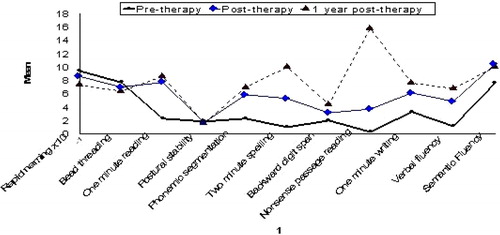
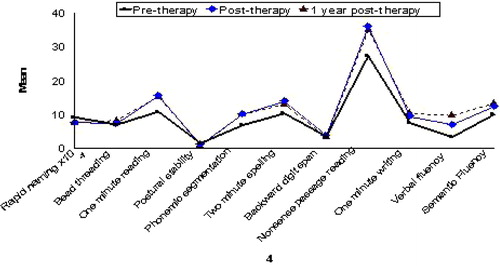
Improvement in performance was noticed after therapy in the first 3 age levels; except the oldest age group; and it continued throughout the year as regards one minute reading, two minute spelling, phonemic segmentation and nonsense passage reading whereby there was stabilization or very mild change in the performance in the rest of items.
NB: In all graphs the rapid naming item was divided by ten to show the differences between the rest of the items.
iv- Evaluation of group II using the Arabic dyslexia assessment on initial evaluation and after the therapy duration (4.2 months) (), revealed no significant difference between the different test items on initial evaluation and after at follow up in the control group at all age groups.
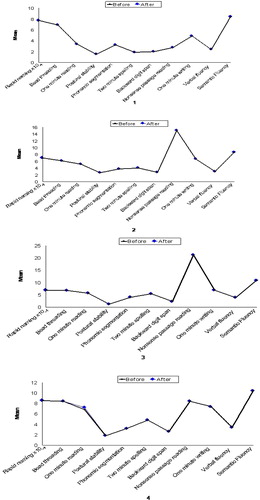
iii- At Risk Index ARI of group I and II: ( and )
Table 2 ARI in group I at different period of follow up.
Table 3 ARI in group II at different periods of follow up.
There was a highly significant difference between the ARI results pre therapy post therapy but there was no significant difference between the results of ARI post therapy and 1 year post therapy (p = 0.0013*). There was no significant difference between the at risk index (ARI) on initial evaluation and after the duration of therapy in group II (p = 0.23).
vi- Comparison between group I and group II after the duration of therapy regarding all test items of Arabic dyslexia assessment test and the ARI: () There was a highly significant difference between group I and group II after the duration of therapy regarding all test items of Arabic dyslexia assessment test and the ARI.
Table 4 Comparison between group I and group II after the duration of therapy regarding all test items of Arabic dyslexia assessment test and the ARI.
7 Discussion
The increased awareness of the impact of Dyslexia on children and their scholastic achievements and consequently on their parents, and the limited resources regarding the therapy of Arabic speaking dyslexic children shed the light on the importance of the development of a structured training program for these children. The training program presented in this study was derived from the phonological awareness training for reading program.Citation9 This program was based on the work of several studies that have demonstrated that training children in phonological awareness has a beneficial impact on their reading skills. Previous studies proved that training in phonological awareness helps developing reading and spelling skills.Citation14,Citation15
The activities in this training program were arranged in a hierarchy from simple tasks to more complex ones and consisted of both analytic and synthetic phonological skills to give better impact on reading skills.Citation16 Because blending skills are much easier to train than analytic skills. The blending skills preceded analytic skills in the presented training program.
There was no need to train all 28 Arabic phonemes. Training in phoneme identity using a relatively small group of phonemes produced substantial increases in performance on tasks using phonemes that had not been trained and thus children can acquire a general understanding of the phonological structure of words.Citation17 The National Reading Panel recommended that the reading intervention programs should provide instruction as phonemic awareness, phonics, reading fluency, vocabulary, and reading comprehension strategies.Citation18 Teaching children to manipulate phonemes with letters; focusing the instruction on one or two types of phoneme manipulations rather than multiple types; teaching children in small groups; and providing explicit instruction that directly teaches children how to identify, count, and manipulate the sounds in spoken words were guidelines to follow in setting the therapy sessions.
Teaching reading includes teaching the reader to understand how letters are linked to sounds (phonemes) to form letter–sound correspondences and spelling patterns. In the present study children used letters to represent the sounds in words and associate a small set of phonemes with the letters that represent them. This systematic phonics program should be implemented in these early grades.Citation19 There is evidence that kindergarten-age children who receive phonics instruction benefit in their ability to read and spell words and comprehend text. Older children in later primary grades receiving phonics instruction are better able to decode and spell words and to read text orally, but their comprehension of text is not significantly improved.Citation20
While important, phonemic awareness is not the only prerequisite to growth in reading skill.Citation21 Phonemic awareness and letter–sound knowledge are needed in combination to promote the acquisition of reading skillCitation22,Citation23 and are both the most powerful predictors of early single word reading skill.Citation20
Reading fluency although of critical importance because text reading that is dysfluent is slow and may impair the child's ability to comprehend, is often neglected in the classroom. The most effective method to build reading fluency is guided oral reading, i.e., reading aloud repeatedly to a teacher, an adult, or a peer, and then receiving feedback.Citation18 The presented training program included some training tasks that gave positive impact on word recognition, fluency, and comprehension at a variety of grade levels.
Researchers found that the effects of phonemic awareness instruction improved when combined with reading instructionCitation24 and spelling activities.Citation25 As interventions for reading comprehension are not well established and were not part of the program, dyslexic cases involved in our study (especially the fourth age group 9.6–10.6 years old) maintained their outcome and showed no significant difference comparing their results post therapy and one year post therapy. In general, the evidence suggests that teaching a combination of reading comprehension techniques is the most effective. When students use them appropriately, they assist in recall, question answering, question generation, and summarization of texts. When used in combination, these techniques can improve results in standardized comprehension tests.Citation18
The current study showed a significant difference between group I and group II in all test items of the Arabic dyslexia assessment test and the at risk index (ARI). There was a significant difference between the scores of the group I pre therapy and post therapy in all test items of the Arabic dyslexia assessment test and the ARI. The difference between the scores of group I pre therapy and post therapy was more marked in younger age groups. One year post therapy the evaluation of the dyslexic children in group I revealed that the results of the first three age groups showed significant difference between the evaluation post therapy and 1 year post therapy, which almost coincides with the suggestion that if reading difficulties are recognized very early, they may be prevented,Citation26–Citation29 while remediation of reading problems becomes increasingly difficult after the third grade.Citation30,Citation31 In older children (group four), there was no significant difference between the results of all test items of the Arabic dyslexia assessment test and the ARI post therapy and 1 year post therapy. Some longitudinal studies indicate that dyslexia is a persistent, chronic condition; it does not represent a transient “developmental lag over time” and that poor readers and good readers tend to maintain their relative positions along the spectrum of reading ability.Citation32–Citation34
Several studies mentioned that deficits in phonological coding continue to characterize dyslexic readers even in adolescence; performance on phonological processing measures contributes most to discriminating dyslexic and average adolescent readers, and average and superior readers as well. Children with dyslexia neither spontaneously remit nor do they demonstrate a lag mechanism for “catching up” in the development of reading skills.Citation35 As children approach adolescence, a manifestation of dyslexia may be a very slow reading rate they may learn to read words accurately, but they will not be fluent or automatic, reflecting the lingering effects of a phonologic deficit.Citation36
In the present study there was a significant difference between the scores of group I pre therapy and post therapy regarding the Phonemic segmentation, Two minute spelling, Nonsense passage reading, One minute reading, and One minute writing tasks. This goes hand in hand with the work of Hecht et al. (2002)Citation37 who proposed that relations between phonemic awareness and spelling skills are bidirectional. The amount of exposure that children had to the treatment intervention contributed uniquely to individual differences in posttest levels of phonemic awareness and spelling.
The present study showed a significant difference between the results of the rapid naming test item between group I pre therapy, post therapy in older children and pre therapy and 1 year post therapy in younger children. This coincides with the work of Vaessen et al. (2009)Citation38 whose study stated that there was no support for the existence of a second independent core naming deficit in dyslexia and indicate that speeded naming tasks are mainly phonological processing speed tasks with an important addition: fast cross-modal matching of visual symbols and phonological codes. This was based on three main findings, these are (a) naming speed was consistently related only to reading speed; (b) phonological processing speed and naming speed loaded on the same factor, and this factor contributed strongly to reading speed; and (c) although general processing speed was involved in speeded naming of visual items, it did not explain the relationship between naming speed and reading speed. This contradicts with the double deficit hypothesis which states that naming speed problems represent a second core deficit in dyslexia independent from a phonological deficit.Citation39,Citation40
8 Conclusion
In the present study we highlighted the importance of phonological awareness skills as a prerequisite for the emergence of literacy skills. The presented training program for dyslexic children was highly structured following the recommendations of the National Reading Panel and modified to suit Arabic speaking Egyptian children. The presented training program significantly improved reading, writing and phonological awareness of dyslexic cases.
Notes
Available online 2 February 2012
Peer review under responsibility of Alexandria University Faculty of Medicine.
References
- S.E.ShaywitzB.A.ShaywitzDyslexia (specific reading disability)Biol Psychiatry5711200513011309
- E.TempleG.K.DeutschR.A.PoldrackNeural deficits in children with dyslexia ameliorated by behavioral remediation: evidence from functional MRIProc Natl Acad Sci USA1005200328602865
- P.B.GoughW.E.TunmerDecoding, reading and reading disabilityRem Spec Educ71986610
- A.F.FarragA.A.El-BeharyM.R.KandilPrevalence of specific reading disability in EgyptLancet286151988837839
- S.Abu-RabiaJ.AwwadMorphological structures in visual word recognition: the case of ArabicJ Res Read2732004321336
- S.Abu-RabiaThe role of vowels in reading Semitic scripts: data from Arabic and HebrewRead Writ1420013959
- G.ElbeheriJ.EverattG.ReidH.al MannaiDyslexia assessment in ArabicJ Res Spec Educ Needs632006143152
- H.Al MannaiJ.EverattPhonological processing skills as predictors of literacy amongst arabic speaking Bahraini childrenDyslexia1142005269291
- J.K.TorgesenB.R.BryantPhonological awareness training for reading kit1st ed.1994Pro-EdAustin, TXp.35–9
- . 1998. Stanford Binet intelligence scale, 4th ed. Quoted and edited by Dr. Maleka LK. Victor Kiorlos Publishing; 1998.
- Wechsler D. Wechsler intelligence scale for children, revised. New York: Psychological Corporation; 1974:p. 32–3.
- M.N.KotbyA.KhairyM.BarakahN.RifaieA.ElshobaryLanguage testing of Arabic speaking children; Proceedings of the XXIII World Congress of the International Association of Logopedics and Phoniatrics; Cairo23199542
- Aboras Y, Abdou R, Kozou H. Development of an Arabic test for assessment of dyslexia in Egyptian children. Bull Alex Fac Med, 2008;44(3):53–662.
- Bradley L, Bryant P. Rhyme and reason in reading and spelling. Ann Arbor, MI: University of Michigan Press; 1985. p. 122–34.
- A.LieEffects of a training program for stimulating skills in word analysis in first-grade childrenRead Res Q23199163284
- Torgesen JK, Morgan ST, Davis C. Effects of two types of phonological awareness training on word learning in kindergarten children. J Educ Psychol 1992;84:64–370.
- B.ByrneR.Fielding-BarnsleyEvaluation of a program to teach phonemic awareness to young children: a 1-year follow-upJ Educ Psychol851991104111
- Report of the National Reading Panel. Teaching children to read: An evidence-based assessment of the scientific research literature on reading and its implications for reading instruction. Bethesda (MD): National Institute of Child Health and Human Development, National Institutes of Health); 2000. p. 14–5.
- Schatschneider Ch, Torgesen JK. Using Our Current Understanding of Dyslexia to Support Early Identification and Intervention. J Child Neurol 2004;19(10):59–765.
- Adams MJ. Beginning to read: Thinking and learning about print. 1st ed. Cambridge, MA: The MIT Press; 1990. p. 352.
- C.JuelP.GriffithP.GoughAcquisition of literacy: a longitudinal study of children in first and second gradeJ Educ Psychol78198643255
- W.SchneiderE.RothM.EnnemoserTraining phonological skills and letter knowledge in children at risk for dyslexia: a comparison of three kindergarten intervention programsJ Educ Psychol922200084295
- D.McGuinnessC.McGuinnessJ.DonohuePhonological training and the alphabet principle: Evidence for reciprocal causalityRead Res Q301995830852
- P.HatcherC.HulmeA.EllisAmeliorating early reading failure by integrating the teaching of reading and phonological skills: the phonological linkage hypothesisChild Dev6519944157
- R.E.O’ConnorJ.R.JenkinsImproving the generalization of sound/symbol knowledge: teaching spelling to kindergarten children with disabilitiesJ Spec Educ293199555275
- J.TorgesenThe prevention of reading difficultiesJ Sch Psychol402002726
- S.E.ShaywitzB.A.ShaywitzThe science of reading and dyslexiaJ AAPOS732003158166
- W.SchneiderP.KuspertE.RothM.ViseShort- and long-term effects of training phonological awareness in kindergarten: evidence from two German studiesJ Exp Child Psychol6631997311340
- C.JuelLearning to read and write: a longitudinal study of 54 children from first through fourth gradesJ Educ Psychol801988437447
- Fletcher JM, Foorman BR. Issues in definition and measurement of learning disabilities: the need for early intervention. In: Lyon GR, editors. Frames of reference for the assessment of learning disabilities: new views on measurement issues. Baltimore: Brookes; 1994. p. 185–200.
- Lyon GR, Identification and remediation of learning disability subtypes: preliminary findings. Learning Disability Focus 1985;1:21–35.
- D.J.FrancisS.E.ShaywitzK.K.StuebingB.A.ShaywitzJ.M.FletcherDevelopmental lag versus deficit models of reading disability: a longitudinal, individual growth curves analysisJ Ed Psychol881996317
- Shaywitz BA, Holford TR, Holahan JM, Fletcher JM, Stuebing KK, Francis DJ, et al. A Matthew effect for IQ but not for reading: results from a longitudinal study. Read Res Q 1995;30:894–906.
- M.BruckPersistence of dyslexics’ phonological awareness deficitsDev Psychol281992874886
- S.E.ShaywitzJ.M.FletcherJ.M.HolahanA.E.ShneiderK.E.MarchioneK.K.StuebingPersistence of dyslexia: the Connecticut longitudinal study at adolescencePediatrics104199913511359
- D.L.LeflyB.F.PenningtonSpelling errors and reading fluency in compensated adult dyslexicsAnn Dyslexia411991143162
- S.A.HechtL.CloseEmergent literacy skills and training time uniquely predict variability in responses to phonemic awareness training in disadvantaged kindergartnersJ Exp Child Psychol822200293115
- A.VaessenP.GerretsenL.BlomertNaming problems do not reflect a second independent core deficit in dyslexia: double deficits exploredJ Exp Child Psychol1032009202221
- Wolf M. A provisional, integrative account of phonological and naming-speed deficits in dyslexia: Implications for diagnosis and intervention. In: BA Blachman, A. Benita, editors. Foundations of reading acquisition and dyslexia: implications for early intervention. Mahwah, NJ: Lawrence Erlbaum; 1997. p. 67–92.
- M.WolfP.G.BowersThe double-deficit hypothesis for the developmental dyslexiasJ Educ Psychol911999415438